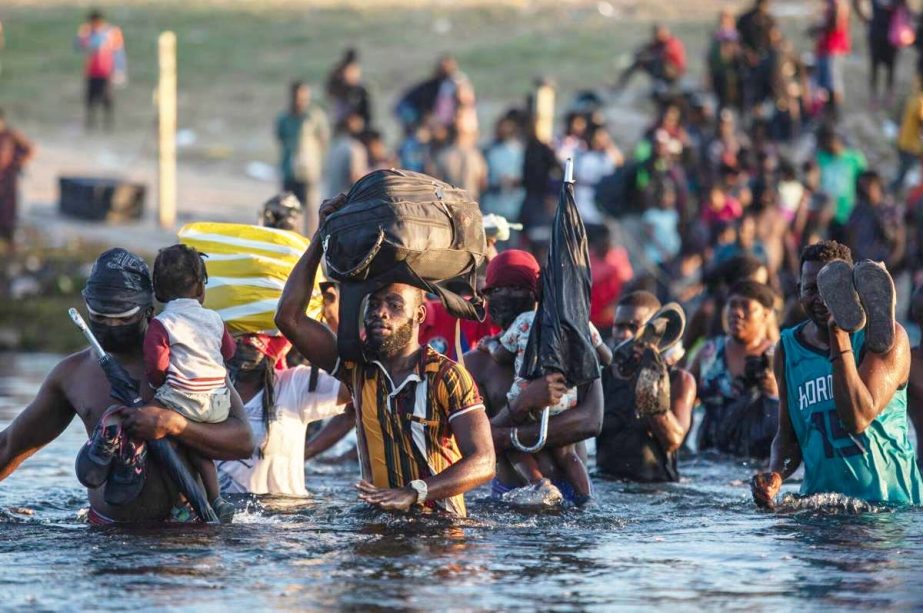
AP, Texas :
The options remaining for thousands of Haitian migrants straddling the Mexico-Texas border are narrowing as the United States government ramps up to an expected six expulsion flights to Haiti Tuesday and Mexico began busing some away from the border.
More than 6,000 Haitians and other migrants had been removed from an encampment at Del Rio, Texas, U.S. officials said Monday as they defended a strong response that included immediately expelling migrants to their impoverished Caribbean country and faced criticism for using horse patrols to stop them from entering the town.
That was enough for some Haitian migrants to return to Mexico, while others struggled to decide on which side of the border to take their chances.
Marie Pierre, 43, stood on the Mexican side of the river as night fell with hundreds of other migrants unsure what to do. She said Border Patrol agents had separated her from her 19-year-old son in Texas and she didn’t know if he had been deported or not. She waited for a chance to charge her phone, hoping to get news from her sister and cousin in Florida.
“They told me he was an adult and couldn’t be with us,” she said of the moment they were separated.
Earlier Monday, Department of Homeland Security Secretary Alejandro Mayorkas conceded it was a “challenging and heartbreaking situation,” but he issued a stark warning: “If you come to the United States illegally, you will be returned. Your journey will not succeed, and you will be endangering your life and your family’s life.”
Officials from Mexico’s National Human Rights Commission walked among the migrants signing up those interested in applying for asylum in Mexico. So far this year, more than 19,000 Haitians have opted to do so, including some now at the border.
At the same time, Mexican authorities were detaining some migrants. The first busloads pulled out Sunday and more empty buses arrived Monday.
Some humanitarian workers said Monday they had seen Mexican National Guard troops help immigration agents detain a group of 15 to 20 migrants in Acuña.
Mexico’s immigration agency did not immediately respond to a request for comment. But a federal official told The Associated Press on Sunday that the plan was to take the migrants to Monterrey, in northern Mexico, and Tapachula, in the south, with flights to Haiti from those cities to begin in coming days.
Authorities stopped some bus lines from operating in the state of Coahuila in an effort to force them not to carry migrants, said Luis Ángel Urraza, president of the local chamber of commerce.

He said the U.S. government’s decision to close the bridge connecting Ciudad Acuna and Del Rio was wearing on the city’s merchants who were counting the days until the migrant population dropped enough to reopen it.
Mayorkas and U.S. Border Patrol Chief Raul Ortiz said they would look into agents on horseback using what appeared to be whips and their horses to push back migrants at the river between Ciudad Acuña and Del Rio, a city of about 35,000 people roughly 145 miles (230 kilometers) west of San Antonio where thousands of migrants remain camped around a bridge.
Later Monday, the Department of Homeland Security issued a statement calling the footage “extremely troubling” and promising a full investigation that would “define the appropriate disciplinary actions to be taken.”
Mayorkas said 600 Homeland Security employees, including from the Coast Guard, have been brought to Del Rio. He said he has asked the Defense Department for help in what may be one of the swiftest, large-scale expulsions of migrants and refugees from the United States in decades.
He also said the U.S. would increase the pace and capacity of flights to Haiti and other countries in the hemisphere. The number of migrants at the bridge peaked at 14,872 on Saturday, said Brandon Judd, president of the National Border Patrol Council, a labor union that represents agents.
The rapid expulsions were made possible by a pandemic-related authority adopted by former President Donald Trump in March 2020 that allows for migrants to be immediately removed from the country without an opportunity to seek asylum. President Joe Biden exempted unaccompanied children from the order but let the rest stand.
Any Haitians not expelled are subject to immigration laws, which include rights to seek asylum and other forms of humanitarian protection. Families are quickly released in the U.S. because the government cannot generally hold children.
Haitians have been migrating to the U.S. in large numbers from South America for several years, many having left their Caribbean nation after a devastating 2010 earthquake. After jobs dried up from the 2016 Summer Olympics in Rio de Janeiro, many made the dangerous trek by foot, bus and car to the U.S. border, including through the infamous Darien Gap, a Panamanian jungle.
Some of the migrants at the Del Rio camp said the recent devastating earthquake in Haiti and the assassination of President Jovenel Moïse make them afraid to return to a country that seems more unstable than when they left.
“It’s not right,” said Haitian migrant Jean Philipe Samus. “The Americans are grabbing Haitians and deporting everyone to Haiti. Haiti has no president, no jobs, there is nothing. In the earthquake a lot of people died. It’s not right over there, I’m going back to Mexico.”
But Mayorkas defended his recent decision to grant Haitians temporary legal status due to political and civil strife in their homeland if they were in the United States on July 29, but not to those being sent back now.
“We made an assessment based on the country conditions… that Haiti could in fact receive individuals safely,” he said.

